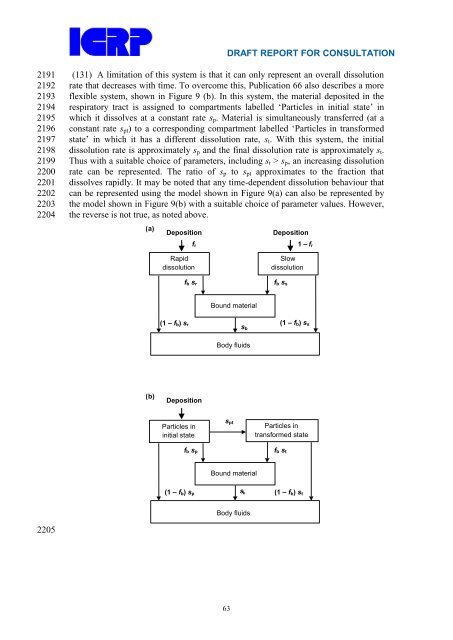Occupational Intakes of Radionuclides Part 1 - ICRP
Occupational Intakes of Radionuclides Part 1 - ICRP
Occupational Intakes of Radionuclides Part 1 - ICRP
You also want an ePaper? Increase the reach of your titles
YUMPU automatically turns print PDFs into web optimized ePapers that Google loves.
2191<br />
2192<br />
2193<br />
2194<br />
2195<br />
2196<br />
2197<br />
2198<br />
2199<br />
2200<br />
2201<br />
2202<br />
2203<br />
2204<br />
2205<br />
DRAFT REPORT FOR CONSULTATION<br />
(131) A limitation <strong>of</strong> this system is that it can only represent an overall dissolution<br />
rate that decreases with time. To overcome this, Publication 66 also describes a more<br />
flexible system, shown in Figure 9 (b). In this system, the material deposited in the<br />
respiratory tract is assigned to compartments labelled ‘<strong>Part</strong>icles in initial state’ in<br />
which it dissolves at a constant rate sp. Material is simultaneously transferred (at a<br />
constant rate spt) to a corresponding compartment labelled ‘<strong>Part</strong>icles in transformed<br />
state’ in which it has a different dissolution rate, st. With this system, the initial<br />
dissolution rate is approximately sp and the final dissolution rate is approximately st.<br />
Thus with a suitable choice <strong>of</strong> parameters, including st > sp, an increasing dissolution<br />
rate can be represented. The ratio <strong>of</strong> sp to spt approximates to the fraction that<br />
dissolves rapidly. It may be noted that any time-dependent dissolution behaviour that<br />
can be represented using the model shown in Figure 9(a) can also be represented by<br />
the model shown in Figure 9(b) with a suitable choice <strong>of</strong> parameter values. However,<br />
the reverse is not true, as noted above.<br />
(a)<br />
(b)<br />
Deposition Deposition<br />
(1 – fb) sr<br />
fr<br />
Rapid<br />
dissolution<br />
fb sr<br />
Deposition<br />
<strong>Part</strong>icles in<br />
initial state<br />
fb sp<br />
(1 – fb) sp<br />
Bound material<br />
63<br />
sb<br />
Body fluids<br />
spt<br />
Bound material<br />
sb<br />
Body fluids<br />
Slow<br />
dissolution<br />
fb ss<br />
fb st<br />
1 – fr<br />
(1 – fb) ss<br />
<strong>Part</strong>icles in<br />
transformed state<br />
(1 – fb) st

















